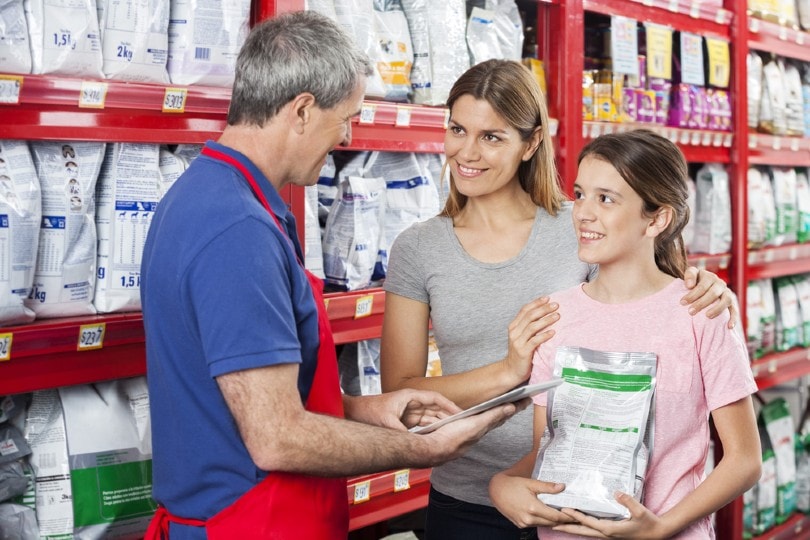How to Calculate Calories in Dog Food: 5 Simple Steps

Updated on

Click to Skip Ahead
As a concerned owner, you want to ensure your dog is getting the right calories to meet all its needs. You can contact your dog food manufacturer for the calorie count per 100 grams (g); some packs of food have this information on them. However, if you want to know how to work out this information yourself, we’ve got you covered!
Read our helpful step-by-step guide for calculating the calories in your dog’s food.
The 5 Simple Steps to Calculate Calories in Dog Food
1. Get to Know the Label
Look for the “Guaranteed Analysis” section that lists the percentages of protein, moisture, fat, fiber, and ash on your packet, tray, or can of dog food. For our purposes, consider on a nutrition label with the following Guaranteed Analysis:
| Protein | 24.0% |
| Fat | 14.0% |
| Fiber | 5.0% |
| Moisture | 10% |
| Ash | 5.2% |
2. Work Out the Carbohydrate Level
To work out the carbohydrate level, add the protein, fat, fiber, ash, and moisture. Then subtract the total from 100.
In our example, the sum would look like this:
Carbohydrate = 100 – (protein 24% + fat 14% + fiber 5% + ash 5.2% + moisture 10%)
So, the carbohydrate level is 41.8.

3. Determine Calories per Gram
The next step is to determine the calories that come from the protein, fat, and carbohydrates. The simple way to work this out is:
- 1 gram of protein = ~3.5 calories (Kcals)
- 1 gram of fat = ~8.5 calories (Kcals)
- 1 gram of carbohydrate = ~3.5 calories (Kcals)
4. Find Out How Many Calories in Each Nutrient

We know from the label that the protein level is 24%, fat is 14%, and carbohydrates are 41.8%. This means that in 100g of pet food, there is 24g of protein, 14g of fat, and 41.8g of carbohydrates.
To get the total calories you have to multiply the figures by the number of calories each gram provides (so, the same number in step 3.)
- 24g x 3.5 = 84 calories. 84 calories come from protein.
- 14g x 8.5 = 119 calories. 119 calories come from fat.
- 41.8 x 3.5 = 146.3 calories. 146.3 calories come from carbohydrates.
5. Finally, Add It All Up
Add all the numbers above from your protein, fat, and carbohydrates to get the total amount of calories:
84 + 119 + 146.3 = 349.3
This means there are approximately 349.3 calories (Kcals) in 100g of this pet food.
 How Do I Use This Information?
How Do I Use This Information?
You have this number, but what do you do with it? Using a calorie counter, you can determine how many calories your dog should be getting each day.
You’ll need an up-to-date, accurate weight for your dog and a target weight from your veterinarian. Your goal is to get your pup to maintain a healthy weight.
An imbalance between your dog’s energy intake and usage can result in either obesity or malnourishment. Obesity in dogs can lead to risks like arthritis and can shave years off their lives. Surprisingly, malnourished dogs can be overweight or underweight when they don’t receive the appropriate nutrition. Underweight dogs can suffer from hair loss, pressure sores, skin problems, lethargy, and permanent organ damage.

How Many Calories Does My Dog Need per Day?
Once you have your up-to-date weight and target weight, there is a formula you can use to estimate the number of calories your dog needs every day. Basically, when your vet is determining your dog’s caloric need, there are a few equations they’ll use:
- Dividing the canine’s body weight in pounds by 2.2 to convert to kilograms (kg)
- Resting Energy Requirement (RER) = 70 x (dog’s body weight in kg)^0.75
- Maintenance Energy Requirement (MER) = appropriate multiplier x RER
When the equation refers to common multipliers, it means extra activity. For example, if your pup is very active, pregnant, or breastfeeding, their caloric intake will be different from a similar size, inactive and overweight dog.
Complement this valuable information by checking out our dog food calculator here:
The exact amount of calories an individual animal needs to maintain a healthy weight is variable and influenced by many factors including genetics, age, breed, and activity level. This tool is meant to be used only as a guideline for healthy individuals and does not substitute veterinary advice
In Conclusion
It may feel like several equations are involved in your quest for a healthy dog, but information about the food you buy is readily available from the manufacturers, online, or with your vet. If you don’t have a calculator handy, there are other ways to access this information. The most vital point we want to stress is to provide a healthy diet and lifestyle for your favorite canine.
Featured Image Credit: BearFotos, Shutterstock


 How Do I Use This Information?
How Do I Use This Information?









